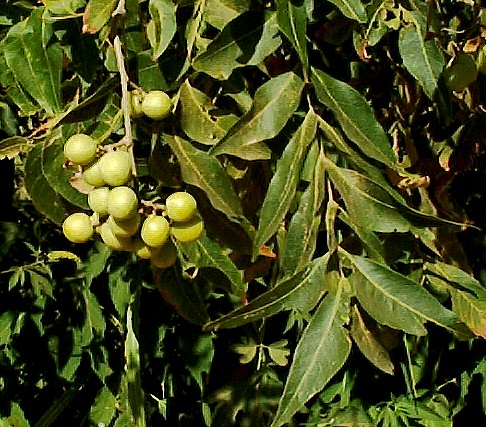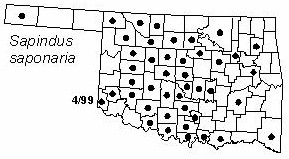
Tree to 12 m (40 ft) tall and 30 cm (1 ft) diameter, with rounded crown. Bark yellowish-gray and smoothish on younger branches, becoming gray and divided into scaly plates. Twigs thin, yellow-green, finely hairy. Buds small, round, with two scales, no end bud. Leaves alternate, pinnately compound, 13-20 cm (5-8 in) long. Leaflets 11-19, lanceolate, almost sessile, 4-7.5 cm (1.6-3 in) long and 1-2 cm (0.4-0.8 in) wide, entire, acuminate, usually glabrous, dull yellow green on both surfaces. Flowers in large upright panicles, 15-25 cm (6-10 in) long, much-branched, numerous, small, yellowish-white, in late Spring or early Summer. Fruits several in a cluster, round, about 15 mm (0.6 in) in diameter, one-seeded, yellow or orange, becoming black and remaining attached through the Winter.
Distribution: Native to an area from Missouri southwest to northern Mexico.
Habitat: Usually found in the floodplains of western rivers, but may sometimes grow in the uplands.
NWI status: none
Comment: The fruits contain a natural detergent and have been used as a substitute for soap. The practice is not recommended, since it causes a skin rash in some people. The fruits are poisonous and should not be eaten. Sapindus is from a Latin phrase meaning "soap of the Indes"; saponaria refers to a soaplike substance called saponin found in the fruits; drummondii honors Thomas Drummond, who collected plants in Texas for Joseph Hooker.
Distribution in Oklahoma: 
BACK
NEXT
RETURN TO INDEX
Last update: 9/20/99
 Go to Oklahoma Biological Survey Home Page
Go to Oklahoma Biological Survey Home Page
 Disclaimer
Disclaimer